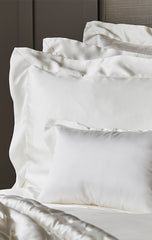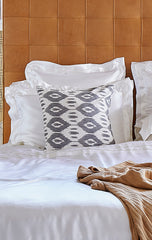Silk vs Satin Pillowcases: Which is better?
Whether your old pillowcase has seen better days and you’ve been searching for a newer, more comfortable choice, or you’re simply considering buying a pillowcase that is kinder to your skin, the chances are you’re wondering what the main differences are between a silk pillowcase and a satin pillowcase. With a similar appearance and texture, at first glance, it can be difficult to distinguish between the two materials. Even if you’ve specifically been looking for a silk pillowcase, you may have come across satin during your search, which is generally considered a cheaper alternative than silk.
However, despite the difference in price, is it worth investing more in silk? And what’s the reason behind these varying prices? In this post, we’ll address these questions by dissecting the silk vs satin debate in its entirety, discussing all the main differences between silk and satin pillowcases, so you can pick the right fabric to help you achieve a blissful nights’ sleep.
What is the difference between silk and satin?
Here to help you make a more informed decision on whether you should use a silk or satin pillowcase, allow us to fill you in on a few facts and answer the most important question of them all: what is the difference between these seemingly similar options? Simply put, silk is made from a natural material produced by silkworms, whereas satin is a manmade (synthetic) fabric, and is created using a specific type of weave.
Most types of satin have been made using a material called polyester, but you can also find ‘silk satin,’ which is made from silk fibres. In most cases, however, satin pillowcases, particularly the options with a lower price, are crafted from synthetic fabrics. It will likely come as little surprise that the main reason for this comes down to cost. Satin pillowcases are cheap to manufacture and can therefore be mass produced without breaking the bank, while the higher-priced silk pillowcase requires a longer, more careful process, which naturally increases the cost.
How can you tell the difference?
With a number of crucial differences, don't be deceived by the two materials’ similar appearance. While both feature a smooth texture and shiny finish, which can make it difficult to distinguish between them, there are some simple differences that make it much easier to uncover whether a material is silk or satin. Usually, it all comes down to three main things:
- Product Information - The simplest way to tell the difference is to look at the pillowcases’ product information. We also advise using this information to identify the type of silk and the quality of the satin - as the quality tends to give you a general idea on whether or not the price can be justified. When it comes to silk, the most important quality indicator to look out for is the momme count, which we cover in more detail in our Guide to Momme Silk.
- Texture - Whether you’re at the shops or you’re shopping online and can request a sample of the material before you buy, you can usually tell the difference between the two materials by feeling the fabric and rubbing it between your fingers. While silk typically features a soft and smooth feel, satin tends to have a rougher texture.
- Surface - Another recommended way to tell whether a pillowcase is made from silk or satin is to angle it to catch the light and check the reverse side of the fabric before running your hands over it. Satin can sometimes have a glossy sheen to it and, depending on the manufacturer, can be dull on one side. On the contrary, silk has a slight shimmer to it.
The Pros & Cons of Silk and Satin Pillowcases
If you’re deciding between a silk or satin pillowcase to complete your bedding set, it’s likely that you’ll want to evaluate the pros and cons of each material before choosing the best option. Despite satin often being the cheaper option of the two, there’s so much more to these materials than affordability, therefore, it’s worth reading up on the benefits before you reach your final decision.
- Cost - Due to the use of cheaper materials as well as lower manufacturing costs, satin pillowcases tend to be significantly cheaper than their silk counterparts. However, this can all come down to quality, so we advise reading the product description before purchasing a satin pillowcase if this is the option you decide to go for.
- Care - Satin can require easier maintenance compared to silk. While the former can be washed in the same way you would with most cotton or jersey materials, the latter requires more specialist care. However, this isn’t always a bad thing. Silk requires careful maintenance due to it being a much more delicate material. If you do as instructed and take extra care while washing this material it’s much more likely to maintain its soft and comfortable feel in the long-term. Our guide on How to Care for Silk details the best ways to keep your pillowcase in top condition, and it's easier than you might think.
- Skincare - As a natural fibre, silk tends to be softer on the skin and hair, which is why it has been hailed by many individuals for its range of skin and beauty benefits. From a reduction in fine lines and wrinkles to leaving your hair feeling silky smooth, silk is well-known for its regenerative properties. Satin, on the other hand, doesn’t have these benefits.
- Hypoallergenic - Due to the proteins it contains, silk is a naturally hypoallergenic material and repels common household allergens, such as bacteria and dust mites. This makes it an ideal choice for allergy sufferers who struggle to get a full nights’ sleep without coming out in an unpleasant rash. However, if allergies persist, it might be worth seeking advice from your doctor.
- Temperature regulating - While both silk and satin have natural cooling properties, silk can additionally adapt to your body’s temperature to create the optimum sleeping environment. Unlike silk, satin is also more likely to stain when it comes into contact with sweat, as it will absorb the excess moisture coming from your skin and hair while you sleep.
Gingerlily Silver Grey Silk Pillowcase - (Varying Sizes - £96.00 - £105.00)

Crafted from the finest long strand mulberry silk, our silver grey pillowcase from our extensive collection of silk pillowcases features a soft, luxurious feel. Perfect for matching with a modern bedroom interior, this luxury pillowcase has been designed in a contemporary-style colourway. Made as part of our silver grey silk bedding set from our signature bedding collections, purchase the full set or mix and match with the other Gingerlily silk bedding collections.
Is silk or satin better for skin?
While both materials help to create a cool and comfortable sleeping environment, silk has a number of additional skin-related benefits. The most common is that it tends to be smoother on the skin and contains a rich amount of nutrients in its fibres. Silk fibres also contain essential amino acids, which can help to replenish the skin by boosting lost collagens - these are an important protein that is produced by the body.
A highly-regarded benefit among silk pillowcase users, this material doesn’t absorb the moisture from your skin, which means it can help to keep it hydrated. Unlike other materials, which can have the opposite effect by robbing your skin of its natural moisture and drying it out, a silk pillowcase can help your skin maintain the right level of humidity. Particularly during the colder months, the hydrating properties of a silk pillowcase, combined with other hydrating products such as moisturiser, can help to reduce the appearance of those unflattering dry flakes that sometimes appear on the skin during cold conditions.
Finally, compared to other pillowcase materials, silk has some useful temperature-regulating properties that set it apart from other, standard pillowcase materials. One of these is that it can help to keep your skins’ temperature at the correct level, allowing you to keep cool in summer and stay warm during winter.
Is silk or satin better for hair?
In addition to holding a number of benefits on the skin, silk also boasts a wide range of benefits for the hair. While both silk or satin are better for hair than regular cotton, silk is generally considered the better material of the two. This ranking is largely based on the compositional difference between silk and satin.
While the natural fibres of silk contain silk protein and other reconstructive amino acids, satin doesn’t feature the same qualities. An artificial material made to reproduce the super soft feel of silk, satin does not contain the vital nutrients needed to improve the feel and health of your hair. To learn more about the miraculous properties of silk and the benefits these can have on your hair, take a look at our blog: ‘What is silk protein and what benefits does it have for your hair?’
However, if hair is lower on your list of priorities in choosing a silk or satin pillowcase, they do share some benefits worth noting. Both silk and satin are smoother materials than traditional cotton or polyester mixes, and the reduction of friction against the hair helps to reduce breakages and frizz. The same can be said for maintaining moisture, as both silk and satin help to retain your hair’s natural oils. These shared benefits make silk or satin pillowcases better for hair than other, more commonly used materials, such as cotton. This stands particularly true if you have naturally wavy, curly or afro hair, which can require more maintenance than straight hair types.
Gingerlily Silk Beauty Box - Mulberry Silk Pillowcase - £66.00
The Gingerlily beauty box is one of our bestsellers and is the perfect product for any newcomer to silk. Silk is recommended by leading dermatologists for its anti-ageing properties and helps to keep skin soft, supple and wrinkle-free. These pillowcases contain the same natural fibres found in our skin and hair, helping to reduce friction and moisture loss while keeping your hair healthy, sleek and shiny.
Shop silk pillowcases at Gingerlily
Hopefully you’ve learned how to identify the main differences between silk and satin and, with its whole host of additional benefits, why silk might be worth the higher price tag. Take a look at our collection of mulberry silk pillowcases and find a pillowcase that will help you achieve healthy-looking skin and hair. If you’re looking for more products to help your skin and hair - browse our collection of silk headbands and eye masks and find your favourite pattern or colourway.



